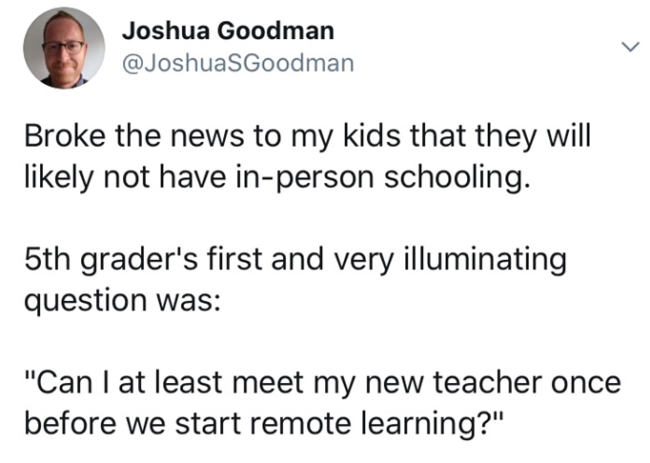08.07.20There are No Easy Choices. But It’s Also Not April

It’s a choice between bad and bad for schools: Do they go hybrid/in-person and risk spreading sickness, or do they go online only and ensure devastating educational losses that will almost assuredly be deeply inequitable?
For those choosing the latter, I want to offer two tiny observations about how this Fall will be different from last Spring.
First, that what we did online last Spring was poor because we did not have time to prepare or plan but it had one thing going for it: the relationships students and teachers had build for six or seven months of face-to-face instruction. This time around we won’t have that foundation. Finding efficient ways to establish and build relationships is critical.
But on the other hand, it’s not April. Thirty kids in a classroom might be impossible, but face to face isn’t what it was at the height of the pandemic either. We all put our masks on now and go to the store. We didn’t do that in April. We’ve figured some things out.
I thought of that when I read a tweet by the economist Joshua Goodman a few days ago.

Goodman’s fifth grader has a point. It would make a huge difference for kids to meet their teacher in person… once… or a few times… to start the year… every couple of weeks…. and what’s remarkable about it is how doable it is. Simple in fact: It’s not April. We can mask up and meet people. Outdoors is very safe. Indoors can be done. It would be so easy to schedule occasional one-on-one get-to-know-yous or meetings.
Imagine if we built them around books. Each 5th grade teacher–choosing at random because that’s Goodman’s child’s age–meets with each kid in her class. She says, “The first book we’re going to read together is X. What if we read the first chapter aloud to each other….” They read it and discuss. Having broken the ice, they then chatted about other things… favorite hobbies, that kind of thing… maybe each kid leaves with a care package of a white board and a set of markers to make classwork more visible online.
If you wanted to go a step further, the teacher could have book groups occasionally. Say it’s three kids and the teacher. Mostly we read aloud together and practice enjoying and sharing a great book. It’s easy for the teacher to prepare. It brings joy and connection to kids. Of course they could be optional for families that don’t want to take a risk–you could do an online version too–but the level of risk for a teacher would be very low and very manageable.
It’s not April, in other words, when every interaction in person was fraught. Even if we’re “Online” there are things we can do.
